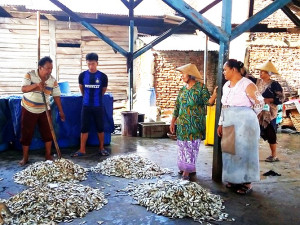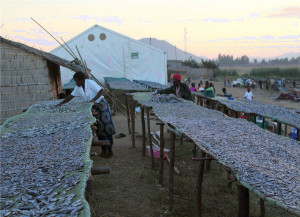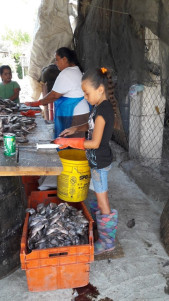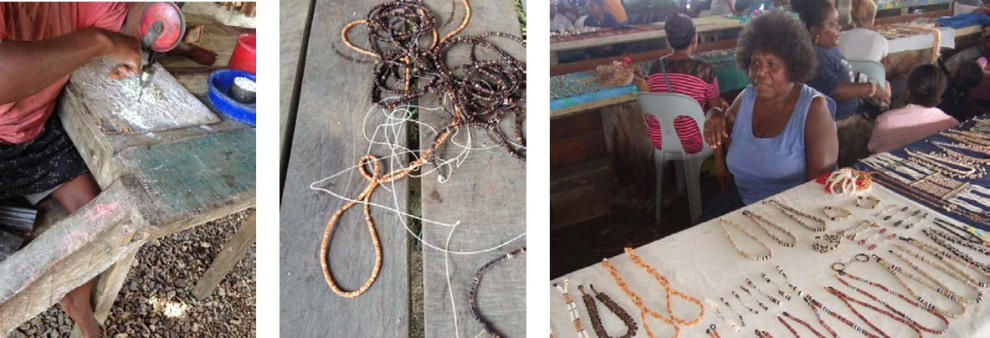
GENDER RESEARCH AS A NEW FRONTIER IN FISHERIES
AND AQUACULTURE ECONOMICS: IN THE FOOTSTEPS OF ROSEMARY FIRTH
Report from the Gender Papers Presented @ 2016 International Institute for Fisheries Economics and Trade Conference, Aberdeen, UK 11-15 JULY, 2016

In 1963, Che’ Yoh and Rosemary Firth discuss qualities and uses of pandanus leaves, Malaysia.
Rosemary Firth (1912-2001) was a British social anthropologist who specialised in the field of domestic economy. In 1941 (republished in 1966) her book, “Housekeeping among Malay Peasants,” tracked the detailed household economics of traditional fishing communities in east coast Malaysia. It was a companion to the book by her husband, Raymond Firth, “Malay Fishermen: Their Peasant Economy.” The 1966 volume of her book gave an account of changes she observed in the 23 years between study visits, and prescient views on the impacts of modernisation on traditional fishing communities.
———
In her acceptance speech for the Distinguished Service Award presented at IIFET-2016, the words of Professor Stella Williams resonated with the focus on women and household economies in the work of Rosemary Firth. “My field research also suggested that there was more to the fisheries than predominantly biological and economic models and stock assessments. I could also see that these approaches focused on environmental sustainability alone were faltering wherever I looked. Indeed, the context of massive and mostly still growing aquatic ecosystem degradation raises the question on what it takes to break that downward spiral,” she said. “Empirical evidence of women’s roles in all continents shows patterns of unrecognised, unpaid labor that clouds the economic signals of increasing resource rarefaction. Extra-efforts expended by women to keep their men in the fishery despite declines in the resource can easily lead to social dumping [use of ever cheaper labor] and unwittingly enables further overfishing.” See our Story on IIFET-2016.
IIFET, with its emphasis on a wide range of inquiry into fisheries and aquaculture resources, trade, marketplaces and livelihoods is an ideal institutional platform for work on women and gender issues. Since 1996, IIFET’s biennial conferences included a small number of papers on women and gender topics and then, in 2012, moved up to holding whole sessions devoted to women in fisheries and aquaculture. In 2012 in Tanzania, the upturn in the number of presentations on gender was helped by sponsorships, especially from AquaFish CRSP, the attraction of having special sessions and also by being in Africa where the importance of women and gender equality were recognized.
In the present report, we build on the results of IIFET-2012 [1] and IIFET-2014 [2] and focus on insights from the 2016 IIFET Conference in Aberdeen, United Kingdom. In Aberdeen, women/gender papers were concentrated in but not limited to the Special Session on “Gender Research as a New Frontier in Fisheries and Aquaculture Economics: In the Footsteps of Rosemary Firth.” This Special Session was supported by the National Atmospheric and Oceanic Administration of the United States of America, the World Bank, IIFET and the presenters.
The 14 presentations and discussions on gender at IIFET-2016 highlighted that sex-disaggregated data and indicators must be improved. Using whatever information they could collect, experts presented gender analyses of value chains in Africa (Malawi and Nigeria), Asia (Bangladesh, India, Indonesia, Sri Lanka, Thailand), North America (Mexico) and the Pacific (Solomon Islands), and global efforts on fisheries performance indicators and data sets. The presenters and participants discussed how, in these value chains, women are critical to adding value to fish, although within the household and society, ultimately men still make most of the key household decisions, sometimes despite interventions that seek to empower women. The gender report concludes by making some suggestions to IIFET in its future work on gender in fisheries economics and trade.
Sex-disaggregated data and indicators must be improved
Triple bottom line (economic, ecological and community) outcomes should include women and men but the ability to be gender-sensitive is limited because much data are not sex-disaggregated, or worse, women are not even counted in all formal aggregated statistics, e.g., if not allowed to register as fishers. Recognizing this latter challenge, Sarah Harper is building a global sex-disaggregated fisheries database on women’s participation, tapping into existing data sources such as formal national statistics, FAO Country Profiles, data from the Sea Around Us project and filling data gaps with information from research studies and other data sources.
For individual fisheries, a new World Bank system of Fisheries Performance Indicators (FPI) has been developed, consisting of 68 metrics grouped under 14 dimensions, of which gender is one. Four sex disaggregated metrics are scored, all nested under the co-management component, namely: business management influence, resource management influence, labor participation in harvest sector and labor participation in post-harvest sector. Jim Anderson pointed out that the metrics can be grouped by each of the bottom line outcomes or by major value chain segments (harvest and post-harvest). To date, data have been collected for 85 individual fisheries. The descriptive statistics show that women are more likely to provide the majority of labor in post-harvest but rarely in harvesting activities, and, based only on the indicators, women appear to have little management or business influence. However, going beyond the indicators, especially when men are frequently absent fishing, women may hold considerable de facto management responsibility and often deal with public management authorities. They rarely get recognition for this. Also, women may wield de facto business power in obtaining access to raw material for their postharvest businesses, but not show this openly in public. The future use of the gender dimension and development of more gender metrics in other components are yet to be explored.

Fish trade in progress, Tambak Lorok fish market, Central Jawa, Indonesia. Photo: Zahrah Izzaturrahim
Zahrah Izzaturrahim, a marine anthropology student supervised by Dedi Supriadi Adhuri, collected daily fish auction data covering all landings of a wide variety of small scale fishing gears and sales to 19 women and 10 men traders at Tambak Lorok fish market, Central Jawa, Indonesia. The data covered one full year (September 2014 to beginning of October 2015). In total, the women combined bought 56% of the total value of the fish; men only bought more fish by value and weight in the period from 20 August to 2 October (2015). Ongoing analysis is looking into the extent that the women’s trading proceeds are being re-invested into the fishing operations of their husband or other relatives. Zahrah and her fellow students had also produced a video that revealed in more depth the highly diverse products and trading practices of the market.
In the Session’s panel discussion, participants stressed the fundamental importance of improved sex-disaggregated data. Governments, international agencies and researchers will need to gather data wherever it is available, e.g., in marketing, harvesting and processing information, and in labor data including sources on migrants and slavery across borders. In addition, researchers will need to undertake analyses on a wider range of social issues than at present.
Gender analysis of value chains can inform policy
Beyond data, more comprehensive approaches and frameworks are needed to incorporate gender issues into fisheries economics and trade analysis. This means going beyond the fisheries/aquaculture stereotypes that privilege the production node and integrating a new awareness around value chains. Several presenters reported evidence that both women and men, often operating in different parts of the value chain, were critical to sustaining the income from fishing, more so in the face of declining resources, climate and environmental threats.
Although the value chain can be an effective framework for investigating gender participation, roles and power relations and seeking entry points for deeper analysis and intervention, unfortunately, Alice Miller pointed out, the gender element is rarely considered. Her work is concerned with the pole and line fisheries in countries such as Indonesia and the Maldives. Across the seafood sector, the profile of the gender dimension needs to be raised, not just in harvesting, but in processing, marketing and management.
IIFET-2016 presenters provided depth to understanding the needs and motivations of women and men in different value chains and different nodes in value chains. Two presentations looked beyond the binary categories of women and men and examined intersectionalities along the dimensions of economic status and power. Three other presentations explored how changes or potential changes can reverberate through value chains by nature of the linkages between nodes and actors.

Women inspecting dried fish product, Malawi. Photo: Chikondi Manyungwa Pasani.
Not all women and men in a fishing community have the same status and assets. Chikondi Manyungwa Pasani found women active in all five nodes of Malawi value chains for usipa (Engraulicypris sadella) and matemba (Barbus paludinosus) – production, collection, processing, trading (wholesale and retail) and exporting – through two landing sites (Kachulu on Lake Chilwa and Msaka on Lake Malawi). In the value chains, fishers’ wives and women auxiliary players performed different roles. The auxiliary players were usually widowed or divorced local women who lacked sufficient capital to go into processing but whom the community allowed to facilitate trade between fishers and processors. When fish were scarce, however, fishermen favoured selling their fish to their wives. The auxiliary players were not included in development interventions even though these women could have helped improve fish quality and returns from the value chains that reached markets in neighbouring countries.

Fish vendor at landing port, Tamil Nadu. Photo: Shyam Salim.
Most fisheries management measures are designed to control harvesting, such as the 45 day seasonal annual trawl fisheries closure in Tamil Nadu and other states of India. Little attention is paid to impacts of such production node measures on various people in other nodes in the value chain. Shyam Salim reported that of Tamil Nadu people affected by the seasonal closures, only one third of the fish workers were the fishermen directly affected; many of the others were women fishworkers. Researchers asked whether women and men present different adaptive responses. Rather than only examining this question as a gender matter, the researchers further stratified the participants according to their economic class based on levels of asset ownership and local power, the latter based on how Panchayat membership is used. Responses were classified as adaptive, e.g., using savings and taking out loans, or reactive, e.g., cutting back on food, pledging jewels as collateral. Statistically, a significant gender divide in responses only occurred when people had no networks and their household assets were low. Women with higher household assets were less likely to use reactive strategies than women with low assets. Men appeared to benefit from networks only when they had assets to contribute, whereas women benefited from networks regardless of asset levels, appearing to be more able to express their needs under pressure. These results caution not to base analyses on simple gender divisions, but to understand the shades of variation in affected people, especially with regard to their levels of assets and power.
In the case of how changes may reverberate through value chains, Achini de Silva showed results from models on the impacts of climate change shocks such as cyclones, droughts, floods and other coastal hazards on people in fish value chains. Climate shocks caused local multiplier effects for women and men in the upstream (production) and downstream (post-harvest and processing, wholesale and retail, and consumption) nodes of small-scale Sri Lankan fisheries in Balapitiya, Beruwala, and in tuna fisheries in Beruwala and Negambo. The study of fishing households used data on incomes from fisheries (initial income), the money spent locally for household requirements and the money that local people, businesses and organizations received and re-spent. It then modelled the gendered multiplier effects under scenarios with normal conditions and those suffering climate shocks. For women and men, the local multipliers for the up-stream nodes were larger compared to those for down-stream nodes. In the case of women, the local multiplier in the down-stream nodes were lower than those for men because the majority of female processing workers were located outside the local area and therefore spent their incomes outside, regardless of climate shock or normal conditions.
On the Mekong River in Nong Khai Province in northeast Thailand, low tilapia prices in the market reverberated in the value chain by disrupting the cage culture responsibilities of different household members. Malasri Khumsri found that, when prices were low, many men migrated for other work, leaving women to take full responsibility for the cage culture. This dynamic should provide the impetus for offering complete training opportunities to the responsible women who played important roles in the practice and decision making on good aquaculture practices (GAP) and environmental care, such as keeping records for monitoring fish health and attending GAP training. GAP implementation should target women specifically and deliver gender-specific programmes to help tilapia cage culture safeguard the environment.
How can analysing small-scale developing country fish value chains inform strategies for poverty alleviation and sustainability? To answer this question in mixed reef fish, octopus and small pelagics value chains for two sites in Kenya and Mozambique, Kongowea and Nanga, Beatrice Crona first mapped these complex, dynamic chains and then wrestled with how to estimate the benefits and their distribution per individual and per value chain group. The people in the chains, namely the numerous small scale women traders (Mama Karangas) and male small scale fishers, small scale male traders (Wachuuzi) and the few large scale male traders and boat owners who control 20% of the supply chain value (Tajiris), each held different aspirations. Policy advice would need to take into account the aspirations, trade-offs and feedback loops in the distribution of benefits. For example, increasing the margins for the Mama Karnagas by lowering their fish purchase price would take money from the fishers, another poor group.
Women are critical to adding value to fish
Shyam Salim, an economist with a long history of work on fish markets and trade in India, concluded that “through their processing, marketing and trading activities, women add the most value to fish. They lengthen the shelf life of the fish by their handling and bring it to consumers at a value greater than that when first landed. Yet, due to gender discrimination, they act as agent middlemen, not merchant middlemen, often are lowly paid or unpaid, and are neglected in health and other services. The Indian Self Help Groups offer some collective help, but even this system needs improvement.”

Girls in Petatán on Lake Chapala, Mexico, learn from a young age how to fillet fish. Photo: Carmen Pedroza.
Petatán, a fishing village on Lake Chapala, the largest lake in Mexico, is home to filleting houses where women process the fish caught from the Lake and surrounding water bodies, making otherwise unsaleable fish marketable in major Mexican markets. Carmen Pedroza found that the work was remunerative for the women, stabilised household incomes against the vicissitudes of fishing income from the lake that is threatened by climate change and pollution, but did not provide the women with social security and health benefits.
In Delta State, Nigeria, Bernadette Fregene surveyed fish farmers, traders∕retailers, fish processors, restaurants, consumers and service providers in the value chains of the major farmed fish (catfish and tilapia). The study found that women fish farmers had lower profits compared to men, largely because the women had less access to the productive assets of paid labor and credit. For women processors, the most lucrative market was for smoked catfish. Cooperatives, if the women were prepared to form them, might make labor and finance more accessible, however, household members would still need to give their consent to the women’s activities.
In the smoked catfish value chain of Ondo State, Nigeria, Ojuotimi Mafimisebi studied the perceptions of women on the utility and adequacy of micro-credit schemes, and the performance of their businesses before and after receiving credit. Although the credit had a significantly positive impact on their business returns, the catfish processors experienced considerable difficulty obtaining funds, especially because of they needed to have a loan guarantor.

Shell money (l. to r.): drilling holes into beads, Strings of beads accumulated by a trade store owner in Langalanga, and selling completed shell money & jewelry at the Honiara Central Market. Photos: Kate Barclay.
Shell money (l. to r.): drilling holes into beads, Strings of beads accumulated by a trade store owner in Langalanga, and selling completed shell money & jewelry at the Honiara Central Market. Photos: Kate Barclay.
In a World Bank study of women in Solomon Islands fisheries, Kate Barclay traced the shell-money value chain from its origins in the heavily populated and overfished Langalanga Lagoon, Malaita. Women and men around Solomon Islands harvested several species of bivalves with different colour shells and sold them to women in Langalanga, who manufactured the beads with simple hand tools. The value chain then took several different forms, with some women turning the beads into attractive traditional and modern jewellery pieces, and taking an accumulated collection of them to sell at the Honiara Central Market. Other women exchanged the basic beads for food at local trade stores, and the traders then finished the manufacturing and sold the pieces in Honiara. Although shell money is critical to local food security in the Langalanga Lagoon, the women who make and sell it have little say in the management of the shell resources they rely on for this activity, or the wider network of livelihood and food production activities in which it takes place.
Men still make most of the key household decisions, despite efforts to empower women
Many presentations indirectly highlighted the need for transformative social change in achieving greater gender equality. One study that addressed this directly was that by Yemi Akegbejo-Samsons who reported on a study of how culture, education and technology affected women’s integration into aquaculture and fisheries in five coastal states of Nigeria – Lagos, Ogun, Ondo, Delta and Cross River. In a cultural sense, local practices, beliefs and laws hindered the women from carrying out some activities, such as fishing at night, or even going fishing at any time. Aquaculture seemed to be more technology intensive than fisheries, and in aquaculture and even fisheries women did not adopt many of the basic technologies. Women’s technology adoption was much more pronounced for fish processing, in which around 40% of the women used smoking technology and a further 20% actively applied packaging and product quality technologies. In terms of education, according to the women surveyed, experience overrode formal education. Although the education standards of the women were considerable – between 22 and 44% having higher education – few had either education or experience in fisheries, aquaculture or their management. Overall, barriers and opportunities due to locally specific conditions in culture, education and technology need to be taken into consideration when promoting women’s integration into fisheries and aquaculture.
Women-friendly technologies, aimed to end women’s drudgery and improve production efficiency, are often recommended as a way to help women. In Khulna, southwest Bangladesh, a project on women and water management introduced several technologies to women to help in raising shrimp and fish. Runia Mowla reported how the women quickly learned and applied the new approaches successfully. In the end, however, men still made most of the farm decisions. Women felt that the technologies had added to their work and to the cost of farming. Despite this, the various technologies seemed be equally used by women and men, and were also considered climate smart.
When women earn an income, they often receive more respect within their households, but this rosy outcome cannot be assumed. Kate Barclay reported how studies in the Solomon Islands revealed that if women have money, male household members may put pressure on them to get control of the money, or, in other cases men may get jealous of women working in the tuna processing factory. These pressures then make the women vulnerable to domestic violence and they may decide to leave their paid work. One initiative that has enabled women to find greater safety at the village level is through protecting their money in women’s savings clubs where cash is secured in safe boxes that require multiple keys to open. Several savings clubs in Solomon Islands have worked very well to enable women to accumulate significant amounts of money.
Malasri Khumsri also found, from international and national experience, that a country’s commitments to gender equality are also critical to the outcomes for women. Despite public pronouncements, many countries do not intend to give priority to gender in their practical and policy programs; international organisations seem to do much better at promoting gender equality and the need for sex-disaggregated data. If the international bodies do not do this, little happens at the national level.
What can IIFET do to promote high quality economics and trade research on gender equality?
Given the major role women as well as men play in supply chains, the IIFET emphasis on trade, markets and resource use is a natural fit with gender studies in fisheries and aquaculture. Gradually, the profile of the gender dimension in fisheries, aquaculture and trade has grown at IIFET conferences, progressing from hosting individual conference papers, to more in-depth theme sessions and now the Rosemary Firth Award for the Best Presentation (later to become for Best Paper) on gender research in fisheries economics and/or trade. The IIFET agenda is being transformed by this greater attention to gender, but can more be done? Discussions during the Rosemary Firth Special Session at IIFET-2016 suggested that more is needed before real progress is visible. Although IIFET does not control the larger sectoral agenda and the research undertaken, as a forum for the exchange of ideas it may influence the agenda. It also stimulates networking of knowledge among practitioners communicating their experiences and sharing them with the more general body of members.
Additional ideas for IIFET to consider are as follows:
- Encourage relevant special and general session leaders to include gender presentations in their conference sessions.
- Encourage top IIFET economists to act as mentors and leaders for gender themes
- Consider have a gender themes in future keynote addresses, and/or encouraging keynote speakers to consider the gender dimension in their addresses.
We note with pleasure that IIFET has welcomed and projected gender balance in its Council and conference prize winners. Although the Fellows, to date, have all been men, this reflects a history of life-time achievement in times where most fisheries economists were men, rather than the current world of fisheries economics.
BACKGROUND INFORMATION
IIFET 2016 Scotland. 11-15 July 2016, Aberdeen, Scotland.
Preliminary report on the gender sessions at IIFET-2016 – LINK
Supporters for the Special Session on Gender Research as a New Frontier in Fisheries and Aquaculture Economics: In the Footsteps of Rosemary Firth.
- National Atmospheric and Oceanic Institute, United States of America
- World Bank, Oceans, Fisheries and Coastal Economies Program
- International Institute for Fisheries Economics and Trade
Rosemary Firth Award
Winner 2016 ($500): Chikondi Manyungwa (Department of Fisheries, Lilongwe, Malawi) for her presentation, “An investigation of women participation in fish value chains and value chain governance in Malawi: a case of Msaka on Lake Malawi and Kachulu on Lake Chilwa”
Highly Commended ($100): Zahrah Izzaturrahim, Department of Anthropology, University of Diporegoro, Semarang, Indonesia for her presentation “Measuring the role of women in fisheries: A Case from Tambak Lorok, Central Jawa, Indonesia.”
[1] See the IIFET-2012 gender sessions summary report at: https://ir.library.oregonstate.edu/xmlui/handle/1957/35352
[2] See the IIFET-2014 gender papers:
- Does women’s empowerment have economic benefits? by Meryl Williams
- Beneficial roles of women in fisheries and aquaculture practices in coastal areas in Bangladesh with some socio cultural confront by Runia Mowla, and Narum Naher
- Towards ecosystem based management of fisheries: What role can economics (aquaculture) play? by Alagie Sillah
- Gender Inequalities Issues in Fish Farming in Southwestern, Nigeria by Abolupe Oluyemi Ayanboye, Zacheaus Olaniyi Oluwafemi, Adebukola Folake Bankole, M.A. Adedokun and O. Adelodun.
- An economic perspective on integrating gender issues in fisheries management and development in the Pacific Islands by Vina Ram-Bidesi.
- A value chain analysis of fish products: Case study from Pantar Island, Eastern Indonesia by Ria Fitriana and Natasha Stacey.
- Role of traditional small scale fisheries in food security and livelihoods: Case of Lake Albert fisher communities, Uganda by Margaret Masette, D. Bamwirire, E. Tinyiro and C Kantono.
- Economics of community-based stock enhancement of abalones in Sagay Marine Reserve, Negros Occidental, Philippines by Nerissa Salayo and Teruo Azuma.
- Socio economic and environmental impact of Ogun River on food security in Ogun State, Nigeria by Iyabode Taiwo, Adebayo Shittu, Samuel Obasa, Mabel Ipinmoroti and Oluyemi Ayanboye.
